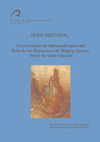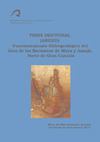Identificador persistente para citar o vincular este elemento:
https://accedacris.ulpgc.es/jspui/handle/10553/18432
| Campo DC | Valor | idioma |
|---|---|---|
| dc.contributor.advisor | Cabrera Santana, María Del Carmen | es |
| dc.contributor.advisor | Custodio Gimena, Emilio | es |
| dc.contributor.author | Hernández Quesada, María Del Pilar | es |
| dc.contributor.other | Departamento de Física | en_US |
| dc.date.accessioned | 2016-09-17T02:30:27Z | - |
| dc.date.accessioned | 2018-06-06T08:17:30Z | - |
| dc.date.available | 2016-09-17T02:30:27Z | - |
| dc.date.available | 2018-06-06T08:17:30Z | - |
| dc.date.issued | 2016 | en_US |
| dc.identifier.uri | https://accedacris.ulpgc.es/handle/10553/18432 | - |
| dc.description | Programa de doctorado: Física, Matemáticas, Geología y Clima | en_US |
| dc.description.abstract | La hidrogeología de Gran Canaria está caracterizada por la existencia de un acuífero único insular, con una superficie piezométrica en forma de domo con flujo radial de centro hacia la costa. A menor escala se encuentran acuíferos diferentes pero interrelacionados. Esta tesis se centra en la caracterización del sistema acuífero de las Cuencas de los Barrancos de Moya y Azuaje, situadas al norte de Gran Canaria, identificada como la de mayor recarga de la isla en sus zonas de cumbre y medianías y en la que el agua subterránea fluye hacia costa, siguiendo el modelo insular... | en_US |
| dc.description.abstract | Gran Canaria Island has an almost round morphology with a conical shape, dissected by deep gullies. The hydrogeology of the island is characterized by an island water table, dome-shaped, with radial flow from the central high altitude areas towards the coast and with some intermediate outflows. On a smaller scale, there different aquifers can be singled out, but interrelated. This thesis focuses on the characterization of the aquifer system of the Moya and Azuaje gullies basins, located at the north of Gran Canaria. The area has been identified as the main recharge zone in the island in its higher and mid elevation parts. Groundwater flows to the coast, with some outflows under natural conditions in the bottom of the gullies, following the insular model pattern. A complex multilayer, heterogeneous and anisotropic aquifer system has been identified. It is composed by a piling of volcanic formations with ages from the Miocene to the Holocene, with different hydraulic parameters. The resolution of deep geology has allowed the identification of the Miocene phonolitic Fm. as the hydrogeological bottom in the area. Rainfall in the study area is characterized by its spatial and temporal irregularity, average of 700 mm/y in high areas and 200 mm/y in the low areas. The study of the chemical composition of rainwater samples containing total (bulk) deposition (dry and wet) has identified the influence marine spray and atmospheric dust contributions and the variability of the rainwater mineralization caused by altitude, distance to the sea, and frequency and amount of rainfall. Groundwater mineralization increases from the high zones to the coast, from HCO3-Na low mineralized and poorly evolved water in the high parts to HCO3-Na, HCO3-Ca and HCO3-Mg waters in the mid areas and Cl-Na, high mineralized waters in coastal areas. A strip of East-West approximate direction with volcanic gases contributions, mainly CO2, has been identified, which favors a higher water mineralization. Neither time evolution of groundwater chemistry nor seawater intrusion has been observed, although there are some wells with high nitrate concentrations. Groundwater exploitation is made through 373 water points, of which 74 are out of use They are mainly 3 m diameter dug wells. In recent decades there has been a progressive drawdown of the water table caused by the high exploitation, which has produced the decrease and disappearance of many of the springs. This thesis has analyzed the spring’s evolution since 1906 and the aquifer chloride mass balance method. The result is a total average recharge of about 9.6 million m3/year in the 67,25 km2 of the area or about an average 142,8 mm/year. The main contribution of this thesis consists in the validated definition of the conceptual model of the aquifer system functioning with hydrogeochemical and environmental isotope support. So it is the scientific basis of later studies. | en_US |
| dc.format | application/pdf | es |
| dc.language | spa | en_US |
| dc.rights | by-nc-nd | es |
| dc.subject | 250605 Hidrogeología | en_US |
| dc.subject | 250804 Aguas subterráneas | en_US |
| dc.subject.other | Barrancos (Geomorfología) | es |
| dc.subject.other | Aguas subterráneas | es |
| dc.subject.other | Barranco de Azuaje (Gran Canaria) | es |
| dc.subject.other | Barranco de Moya (Gran Canaria) | es |
| dc.subject.other | Hidrogeología. | es |
| dc.title | Funcionamiento hidrogeológico del área de los barrancos de Moya y Azuaje, Norte de Gran Canaria | es |
| dc.type | info:eu-repo/semantics/doctoralThesis | en_US |
| dc.type | Thesis | en_US |
| dc.type | Thesis | en_US |
| dc.type | Thesis | en_US |
| dc.type | Thesis | en_US |
| dc.type | Thesis | en_US |
| dc.type | Thesis | en_US |
| dc.compliance.driver | 1 | es |
| dc.contributor.departamento | Departamento de Física | es |
| dc.identifier.absysnet | 727191 | es |
| dc.investigacion | Ciencias | en_US |
| dc.rights.accessrights | info:eu-repo/semantics/openAccess | es |
| dc.type2 | Tesis doctoral | en_US |
| dc.description.notas | La fecha de publicación es la fecha de lectura | en_US |
| dc.utils.revision | Sí | en_US |
| dc.identifier.matricula | TESIS-691838 | es |
| dc.identifier.ulpgc | Sí | es |
| dc.contributor.programa | Física, Matemáticas, Geología Y Clima | es |
| item.fulltext | Con texto completo | - |
| item.grantfulltext | open | - |
| crisitem.author.dept | GIR IUNAT: Geología de Terrenos Volcánicos | - |
| crisitem.author.dept | IU de Estudios Ambientales y Recursos Naturales | - |
| crisitem.author.parentorg | IU de Estudios Ambientales y Recursos Naturales | - |
| crisitem.author.fullName | Hernández Quesada,María Del Pilar | - |
| crisitem.advisor.dept | GIR IUNAT: Geología de Terrenos Volcánicos | - |
| crisitem.advisor.dept | IU de Estudios Ambientales y Recursos Naturales | - |
| crisitem.advisor.dept | Departamento de Física | - |
| Colección: | Tesis doctoral | |
Visitas
342
actualizado el 25-ene-2025
Descargas
1.380
actualizado el 25-ene-2025
Google ScholarTM
Verifica
Comparte
Exporta metadatos
Los elementos en ULPGC accedaCRIS están protegidos por derechos de autor con todos los derechos reservados, a menos que se indique lo contrario.

